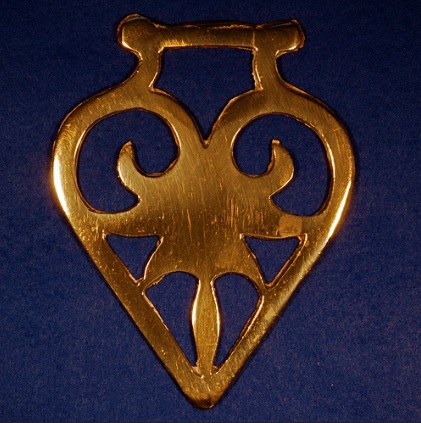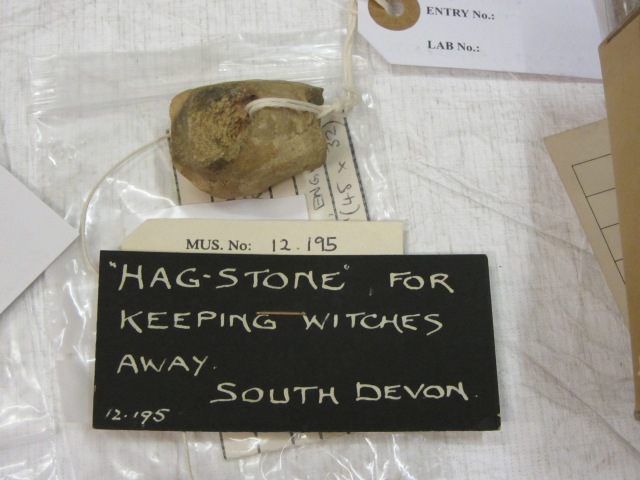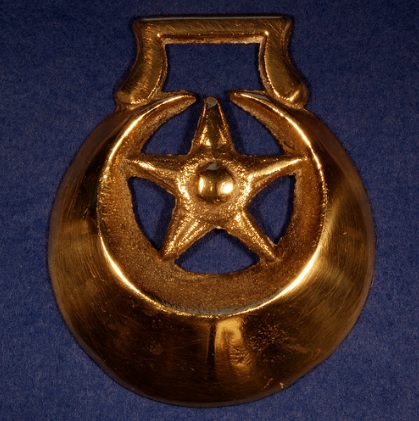Reading Alan Garner’s collection of essays in The Voice That Thunders (1997), I came across a really interesting example of ritual concealment. At an unspecified date in the past, Mr Garner was sitting in a house in the Mawddwy Valley, Wales, with an elderly friend called Dafydd. Dafydd announced that he would like to bequeath to him his ‘Beauty Things’, which Mr Garner describes as ‘junk beyond price’; the objects we accumulate through our lives that are simultaneously valueless and invaluable.
As Mr Garner writes, Dafydd retrieved the first of his ‘Beauty Things’ to give him:
‘He reached up into the chimney and pulled down a soot-blackened set of horse brasses. They may have been made in Birmingham for tourists, but Dafydd had used them correctly: as apotropaic talismans; good luck insignia for a harvest; offerings to earth for breaking her’

This is the first reference to the apotropaic function of horse brasses that I’d come across. I was vaguely aware of the fashion of adorning horses with decorative discs of brass, but didn’t know their names – and certainly didn’t know that there’s folklore behind them. As Lovett wrote in his 1925 Magic in Modern London: ‘It is almost impossible to walk through London without meeting with horses (usually cart horses) bedecked with certain brass ornaments; and it is almost equally impossible to meet with anyone who knows what they are, or what they mean.’

In early 20th-century London, horse brasses didn’t belong to the owners of the horses, but to the carmen, and they appear to have been passed down through the generations. But according to Lovett, even most carmen weren’t aware that their function went beyond the decorative: ‘they are, or were, amulets to ward off the effects of the Evil Eye’.

Why would the horse brass have the power to repel the Evil Eye? Lovett has a few theories. Firstly, its association with the horse itself, an animal that was particularly liable to the attention of malign forces. It was popularly believed that if a horse was discovered covered in sweat in the morning, then it had been ‘pixie-ridden’ or ‘hag-ridden’, meaning that a pixie or witch had stolen and ridden it through the night. Below is a woodcut image from the Nuremberg Chronicle (1493), depicting a witch and the Devil riding a horse.

To prevent this from happening, another apotropaic device was employed: the ‘hag-stone’: a stone with a naturally-occurring hole running through it, hung up in a barn or stable.

So the horse needs protection from malevolent forces, and the horse brass is particularly effective for two reasons. Firstly, it’s made from metal, the most potent of apotropaic materials. And secondly, it instantly draws the eye through its shiny, bright colour and its swaying movement on the horse. It was believed that only the very first glance of the Evil Eye caused harm, and so the horse brass lured the malign gaze away, acting as a kind of lightning conductor. And over time it appears to have shifted its function from a charm used to protect horses, to one used for protecting homes. As Lovett remarked, ‘It is exceedingly difficult to trace back these brass amulets in an unbroken line to their first appearance as horse charms, but we find them still surviving in odd and out-of-the-way places’ – like up a chimneybreast in the Mawddwy Valley!

Hello Ceri
There’s a horse brass in the collection of Keighley’s Cliffe Castle Museum that is a classicexample of an evil eye deterrent, in the manner of Mediterranean/Middle Eastern artefacts. I’ll email you a photo if you’re interested.
See you at Hidden Charms in Norwich on April 2!
LikeLike
Hello John,
Ooh thank you, please do email me a picture if that’s okay. And yes, I’ll see you in Norwich – I’m really looking forward to the conference!
Many thanks, Ceri
LikeLike